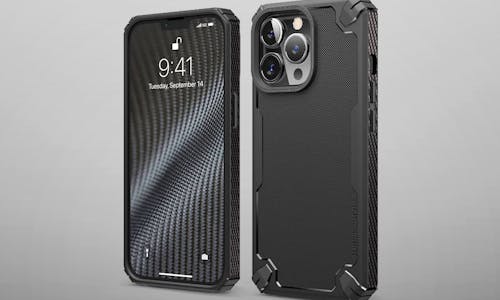
The BlackBerry Playbook has arrived, and it’s an interesting direction for RIM.
The first tablet from the smartphone specialists, it most definately looks the part; a black monolithic tribute. With a smaller sized 7-inch touchscreen, it’s still belts out an impressively high-resolution image, capable of full high-definition video play-back.
You’ll notice there’s no physical touch-button on the front of the device, and any buttons on the PlayBook are confidently styled and petite, and hidden on the top edge.
When the screen goes into sleep, one tap and it’ll return to what you were doing. You can swing out and between apps using a combination of swipes.
Switching between the web-browser, media players, email and other apps is done with a swipe to the left or right. You can then close them with a swipe upwards. There’s also a small kill-box ‘x’ if you’re not the swiping kind.
The web-browser is zippy, and it isn’t all down to the dual-core processor inside, though we’re sure it helps. We were impressed by how quickly the webpages appeared on the PlayBook, and flash content loaded up just as easily. We think a good test of the web-browser is BBC’s iPlayer, and videos played faultlessly.
RIM are going after their business customers, with a ton of Bridge features; connecting and syncing the PlayBook to your BlackBerry. We’re waiting for the arrival of a new BB to test it all out ourselves.
There’s a lot of features for the security conscious user, as well as word-processing, spread-sheet and other office programs already installed.
Click on for more hands-on impressions and photos of RIM’s tablet. Expect to see our review on Recombu next week.

The front-facing camera is a 2-megapixel 3-megapixel affair, and will allow you to conduct video-calls with other PlayBook users.
At the moment, this means you can only call Americans, Canadians, and British tech journalists, but if it’s bought across businesses, you can easily call colleagues using their unique BlackBerry number as a pseudo-phone number.

On the bottom edge, there’s three ports. This includes a magnetic docking contact, which charges the PlayBook, microUSB to charge and exchange files, and microHDMI for connecting to larger displays.

Here’s those understated control buttons; volume control, pause/play and power.
The power button is initially fiddly, but once you get used to pressing the general area, and not precisely the button itself, it never gets in the way.

The rear-facing camera has a five-megapixel sensor, and can also record fulll-HD video. This can then later be shared either through the PlayBook’s own screen, or shared through the miniHDMI port.
DNLA-capability is also here, if your TV has those initials written somewhere on it.
Even whilst sharing content, you can still multitask and return back to your emails while videos continue to play.
As you can tell by the multitude of stickers and warnings, we’ve been given a US model to review, and we’ll be sure to re-test and adjust our review when a UK update arrives- there will be some changes to the apps found on the launch model in the UK.

Here’s the camera in action. Given the ease in using the BlackBerry with one hand, we’ve found it the best tablet to use for photography- not that we would that much.
Note that there’s no flash on this one, something Motorola’s Xoom did manage to add.

There’s even more options if you swipe down from the top. This opens up the “menu” in most apps on the PlayBook.
Here you’ll find; image stabilisation, picture ratio, and lighting settings, including automatic, sports and whiteboard. The last option means you can take a crafty snap of slideshows and computer screens, and it won’t appear all washed out.

This is the main screen, filled with the pre-loaded apps and any more you download from the BB app store.
You can re-order them, and some will be assigned to media and games, with your ‘favorite’ apps getting its own customisable section.

Several apps already found on the main-screen aren’t stand-alone apps, but work through the web-browser.
At the moment, that includes Gmail and Twitter, though we’re sure it won’t be long until there’s some apps available for these and other popular sites. A Facebook app is already on the PlayBook.

Here’s the multi-task screen. It’s like HP’s webOS but even more heavily integrated. Swipe down to expand the app, swipe left and right to switch between them. Swiping up will also close any unnecessary apps.
Other swipe controls include swiping from the bottom left, and a touchscreen keyboard magically apparates.

RIM have played with the web-browser found on previous BlackBerries, and it’s been overhauled and adjusted to make the best use of the extra screen-space and power.

Rotate the PlayBook and the screen switches to portrait, and the webpage is reshuffled to fit.

A quick double-tap and a text-box will also be re-sized. We’ve seen this on Android before, but we liked it then, and we still do now.

The PlayBook’s app store gives you the chance to add even more to your PlayBook.
It’s currently all done in US dollars, but our test model will be getting the upgrade when UK software is released.

Line them up against each other, and it’s difficult to believe they’re rivals. The size difference is startling. In one hand, the PlayBook is far more friendlier, but the iPad has that larger screen. Decisions, decisions.

The PlayBook looks far brighter than our iPad. It’s a case of similar resolutions, different proportions.
The screen ratios are also different, the PlayBook seems better suited toward films- there’s no waste black screen when video is played in widescreen.

The PlayBook is deceptively weighty in the hand, but it’s never too much for one hand.

Thickness-wise, there’s not much between the two; the PlayBook is uniformly the same thickness, but the centre of the iPad is actually thicker.

Leave a Reply